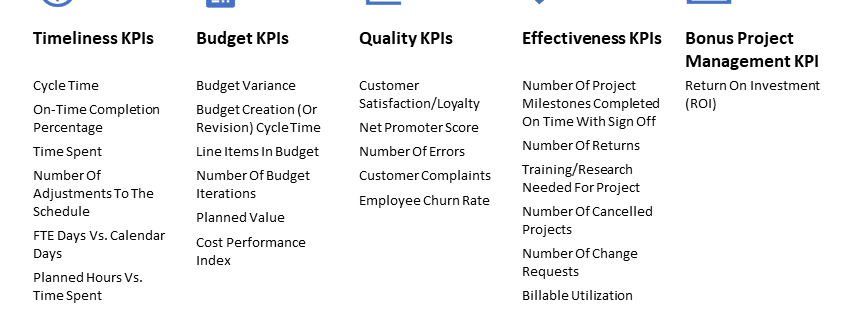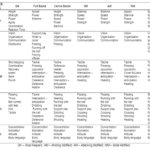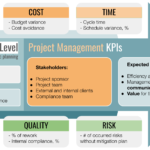Tracking KPIs during your project lifecycle can help you understand where you’re succeeding and where you aren’t. Here are a few to get you started.
Tracking key performance indicators (KPIs) or measures is critical during a project. Without them, it’s difficult to see how you’re progressing toward your goals. But how do you know what you should measure for each project? Overwhelming your team with data won’t make the project succeed, but providing the right data, at the right time, ensures the project stays on track—so you can get started with the next one!
What are Project KPIs and their Four Categories?
These are the four categories under which you should be thinking about your project management KPIs. We have listed the categories and a simple definition below:
- Timeliness: This is making sure your project is done on time—and if it’s not, tracking where it’s off-target is important so you can always have an estimated completion date.
- Budget: Are you going to stay under the budget you’ve allocated, or is the project exceeding costs?
- Quality: How well has the project progressed? Are those working on it or benefitting from it satisfied?
- Effectiveness: Are you spending your time and money appropriately, or could you be managing the project more effectively?
We’ve included an image to take with you containing the four categories containing 25 sample KPIs for project management. Below the image, you’ll find additional details about each KPI. Note: You will not need all of these measures, but hopefully they help you think about better ways to manage your projects. These KPIs can be used regardless of what project management methodology you use. Check out some of our favorite project management books for more insights on project management processes.
The 25 Most Important Project Management KPIs
Timeliness KPIs
- Cycle Time: The time needed to complete a certain task or activity. This is helpful for repeated tasks in a project.
- On-Time Completion Percentage: Whether or not an assignment or task is completed by a given deadline.
- Time Spent: The amount of time that is spent on the project by all team members—or, if you like, by each team member individually.
- Number Of Adjustments To The Schedule: How many times your team has made adjustments to the completion date of the project as a whole.
- FTE Days Vs. Calendar Days: How much time your team is spending on a project by calendar days, hours, and/or full-time equivalent work days.
- Planned Hours Vs. Time Spent: How much time you estimated a project would take versus actual hours. If the time spent differs from the amount of time anticipated, it’s a flag that you underestimated the resource allocation or budget, and your timeline may be affected.
- Resource Capacity: The number of individuals working on a project multiplied by the percent of time they have available to work on it. This project KPI helps to properly allocate resources (and determine any hiring needs) and set an accurate project completion timeline.
- Resource Conflict YOY: Comparing the number of projects with resource conflicts year over year (YOY). Not having the resources to complete projects or having employees assigned to several projects at a time can lower efficacy. KPIs that compare these conflicts will show whether the situation is a persistent problem or one-off situation that needs to be addressed.
Budget KPIs
- Budget Variance: How much the actual budget varies from the projected budget. To track this KPI, measure how close the baseline amount of expenses or revenue is to the expected value.
- Budget Creation (Or Revision) Cycle Time: The time needed to formulate an organization’s budget. This includes the total duration of research, planning, and coming to a final agreement.
- Line Items In Budget: Line items helps owners and managers keep track of individual expenditures—and provide a more detailed way to see how the budget was spent.
- Number Of Budget Iterations: The number of budget versions produced before its final approval. A higher number of budget iterations means more time is being spent planning and finalizing a budget.
- Planned Value: The value of what’s left to complete in a project—in other words, the planned cost of what still needs to be done. For example, if you have a $20K budget and 30 percent of the project remaining, the planned value of the remaining work is $6K. Use this project KPI to compare against the actual cost and adjust the budget if needed.
- Cost Performance Index: Compares the budgeted cost of the work you’ve accomplished so far to the actual amount spent. This is a ratio to measure the expense efficiency of a project—earned value divided by actual costs.
Quality KPIs
- Customer Satisfaction/Loyalty: Whether or not someone is satisfied and would come back again. This can be measured effectively by a survey. This comes more into play when the project deals directly with a client or customer.
- Net Promoter Score: Similar to customer satisfaction and loyalty, NPS (or Net Promoter Score) is a user satisfaction KPI measured by a one-question survey whose purpose is to gauge brand loyalty.
- Number Of Errors: How often things need to be redone during the project. This is the number of times you have to redo and rework something, which affects budget revisions and calendar revisions as well.
- Customer Complaints: Keep in mind that the “customer” of a project could be someone internal—does someone from your organization complain because someone else isn’t getting things done?
- Employee Churn Rate: The number or percentage of team members who have left the company. If your project teams have high turnover, it might indicate the need to improve management and the work environment. Churn ultimately slows down projects and creates higher costs for the company in the long run.
Effectiveness KPIs
- Number Of Project Milestones Completed On Time With Sign Off: There are different parts within a project—are they being completed in a timely manner? Additionally, were the milestones completed and approved by the owner or buyer?
- Number Of Returns: If you have a capital project that requires many parts, you may track the return rate of those parts; this helps you see if you did a good job planning or adjusting to the project during implementation.
- Training/Research Needed For Project: You may track this in hours, number of courses, or something similar. If you need to do a lot of this, your project might get started later than you hope. Another way of looking at this is asking, “What percent of resources did you have at the beginning of the project that were qualified to immediately begin working on the project?”
- Number Of Cancelled Projects: Tracking how many projects have been paused or eliminated. A high number of cancelled projects could indicate a lack of planning, lack of goal alignment, or an inability to take on new projects.
- Number Of Change Requests: The number and frequency of changes requested by a client to an established scope of work. Too many changes can negatively affect budgets, resources, timelines, and overall quality.
- Billable Utilization: The percentage of project hours you can bill to a client. Billable hours relate to revenue-generating, project-related tasks, whereas unbillable hours are typically more administrative, including things like drafting and negotiating proposals.
Bonus Project Management KPI
- Return On Investment (ROI): Encompassing all of the previous four KPI categories, ROI calculations measure the financial worth of a project in relation to its cost. Will the project result in a positive payback for the company or client? What is its financial potential or value? Are there other projects or investments that would yield a higher ROI? This KPI is often used when determining whether to initiate a project, or to compare the value of two different projects.
What makes a good KPI?
Choosing which project management KPIs to track and measure is only the first step. Next, you have to define your KPIs in a manner that gives them clarity and focus. There are project management KPI templates you can use to help, but it’s most important to remember to be S.M.A.R.T. With this acronym as your guide, you’ll be able to create effective project measures that are:
- Specific
- Measurable
- Attainable
- Realistic
- Time-Bound
Your KPIs should be agreed upon by all involved parties before initiating a project, and then measured and monitored as a tool for decision-making during the project.
In Summary
A project has many moving parts regardless of what project management methodology (like waterfall or agile) you use, and it is critical that you measure the timeliness, budget, quality, and effectiveness of the project along the way. You need to be sure you are able to execute on these projects effectively with a limited budget—because resources aren’t unlimited. (If you had unlimited resources, you’d probably do things a lot differently!)
By: Amanda Atrash






